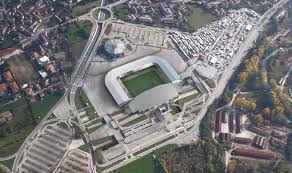December 11 – The Udine city council has approved a comprehensive redevelopment plan for Stadio Friuli, home to Serie A club Udinese.
The project aims to transform the stadium, also known as the Bluenergy Stadium, into a multifunctional hub for sports, culture, and commerce.
“The Stadio Friuli represents one of the most important assets of our city, a place where sport expresses itself at its highest levels, bringing the image of Udine to an international stage,” said Udine Mayor Alberto Felice De Toni.
“With the Stadio 2.0 project, our city will be increasingly at the forefront by making available to fans and citizens a structure among the most complete in Europe.”
Spanning 20,000 square metres, the redevelopment will include the construction of restaurants, a commercial area, a sports centre with a swimming pool, a hotel, and a sports museum dedicated to the Friuli Venezia-Giulia region. The commercial area, covering 1,500 square metres, will accommodate a mix of clothing retailers, technology outlets, pharmacies, and health stores.
Beyond commercial ventures, Udinese has proposed additional facilities such as a music school, spaces for concerts and dance performances, and recording studios.
The club envisions the revamped stadium as a year-round destination that will serve as “a nerve centre for the local community,” attracting visitors while creating economic and tourism opportunities.
“We believe that this green light is an important step that will bring further great benefits to the city of Udine and to the whole of Friuli Venezia-Giulia which, since Udinese built the new stadium, have drawn enormous advantages in terms of attractiveness of the territory given the great international events that we have been able to host thanks to our jewel of a stadium,” said Udinese administrative director Alberto Rigotto.
“Now, finally, once the details have been ironed out, we will be able to complete the project that will make the Bluenergy Stadium a true sustainable hub of services for the community alive 365 days a year”.
The stadium was opened in 1976 and currently boasts a capacity of 25,144 after two renovations – one in 1990 and later a three-year project ending in 2016.
Contact the writer of this story, Harry Ewing, at moc.l1745936262labto1745936262ofdlr1745936262owedi1745936262sni@g1745936262niwe.1745936262yrrah1745936262
